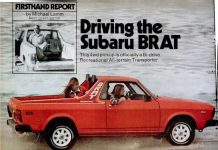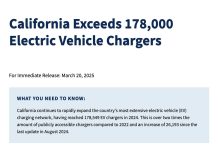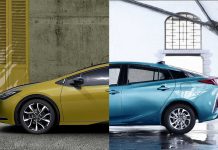Lincoln used to be right there with Cadillac as one of the top luxury car brands on the market.
In the mid-late 1990s, Lincoln actually outsold Cadillac.
Fast forward to 2011 and Lincoln’s hardly even got its foot in the luxury car door anymore – the result of a series of missteps and stumbles (Mark VIII, LS sedan), also-rans (Continental) and belly flops (Blackwood, Mark LT).
Lincoln has become Ford’s Buick – a nice but not-quite-top-of-the-line brand. Instead of going head to head against Caddy (and Audi, BMW, Lexus and the rest of them) Lincoln seems to be targeting near-luxury stuff like – you guessed it – Buick.
Of course, that means Ford doesn’t really have a premium brand anymore.
And that could be a real problem for Lincoln – and cars like the 2011 MKS.
WHAT IT IS
The MKS is a large luxury sedan. It comes in both front-wheel-drive and AWD versions and is powered either a naturally aspirated 3.7 liter V-6 or a twin-turbo 3.5 liter “EcoBoost” V-6.
Prices start at $41,270 for a base FWD model with the 3.7 liter engine; a top-of-the-line AWD version with the turbo 3.5 liter engine starts at $48,160.
Competition includes the Buick Lucerne and – maybe, if you overlook a few things – AWD-equipped luxury cars like the Audi A6 and Acura RL, among others.
WHAT’S NEW FOR 2011
The MKS is about three years old now. Last year, Lincoln upped the underhood ante by adding a 3.5 liter, 355 hp EcoBoost twin-turbo V-6 to the options list. It’s the same basic engine used in the current Taurus SHO.
For 2011, the MKS also gets High Definition radio and Ford’s Sync voic-activated media-entertainment integration system.
WHAT’S GOOD
A plush, sofa-like ride.
Calming lack of excess techno-junk. You don’t need to spend days reading manuals to understand how to operate the gear shifter or how the stereo controls work.
EcoBoost 3.5 liter V-6 delivers great performance and better fuel efficiency than base 3.7 liter V-6. It’s also stronger than the engines used in the Acura RL and Audi A6.
Much more available power/performance than you get in a Buick Lucerne – and that includes the V-8 Super version.
Available AWD (Lucerne is FWD only).
WHAT’S NOT SO GOOD
Second-tier brand status.
Mediocre acceleration with standard 3.7 liter engine – along with hearty appetite for gas.
Pricey for what you get (and don’t get).
UNDER THE HOOD
The standard engine in the ’11 MKS is a 3.7 liter V-6 rated at 273 hp. It is paired with a six-speed automatic and either FWD or (optionally) AWD.
So equipped, the MKS takes about 7.5-7.7 seconds to make it to 60 mph, which is neither especially quick nor particularly slow. It’s solidly average.
On the downside, the 3.7 liter engine chugs gas down at the rate of 17 city, 24 highway (FWD).
AWD-equipped versions do about 1 MPG worse on both counts.
The optional MKS engine is a twin-turbo 3.5 liter V-6 that’s rated at 355 hp. It also comes with the six-speed automatic.
AWD is mandatory with this engine.
Acceleration much-improved with this engine (0-60 takes about 6.8 seconds) and even better – there’s no fuel economy penalty to pay. The EcoBoost-equipped MKS (even with AWD) pulls down 17 city, 25 highway – better gas mileage than the FWD MKS with the much less powerful 3.7 liter engine.
The only fly in this pie is the EcoBoost V-6 expects to be fed premium unleaded while the base 3.7 liter engine runs fine on regular.
ON THE ROAD
The MKS is pretty much the only $40k luxury car on the market that’s still FWD in its standard-issue form.
When it first came out two years ago, it was the only full-size luxury car in that price range that was offered only with FWD.
The Buick Lucerne – a similar car in many respects – is also FWD, but it starts at $29,730.
FWD does have several advantages, of course. It allows for better packaging of the engine/transmission/axle assemblies – which usually gives more interior space since most of the car’s drivetrain is up front rather than spread out along the length of the floorpan. You usually have better traction in the rain and snow, too – relative to a RWD car.
The downside is that FWD cars don’t handle as well under high-speed loading especially – because they’re nose-heavy – and because the front wheels are tasked with both steering and putting the engine’s power to the ground.
It’s not that it handles poorly. There’s some body lean, but it’s not nautical – and the steering tracks nicely with the road. It’s just not a BMW (or even a Cadillac). But it is an easy car to drive and it has a nice, “big car feel” to it. Personally, I like it. And 20 or so years ago, when “luxury” meant “soft, quiet and smooth,” the MKS would fit the bill for nine out of 10 luxury car buyers. The 50-plus set that typically bought a luxury sedan wasn’t into W-rated 150 mph low-aspect ratio tires, trail-braking or apex-taking. They just wanted a four-wheeled refuge from the outside world.
If that’s you, the FWD MKS won’t disappoint.
Except, of course, that you can buy a very similar car in the form of the Buick Lucerne for about $11k less. It’s true the Buick’s got less horsepower (a 3.9 liter, 227 hp V-6 is standard) but the typical buyer is probably not going to sweat that.
But that $11k price gap? That’s something you can’t help noticing.
The AWD version of the MKS with the powerful EcoBoost engine offers quicker acceleration and much better handling on dry roads as well as in the rain/snow than the FWD-only Lucerne.
But, holy canoli, that $48k MSRP!
You could get a Lucerne Super with a V-8 for $44,460. Granted, still no AWD and the V-8 produces less than 300 hp. But it’s still a V-8 and that does add some high-end panache – and the Super’s price still leaves you with about $4,500 in your bank account, too.
Almost $50,000 for an MKS is as hard to swallow as a wheelbarrow full of pig knuckles when you shop around a bit more and discover that $46,830 could buy you something like the outstanding AWD Acura RL – or, for just a bit more ($50,200) an Audi A6 Quattro.
$50k is for the MKS is seriously pushing it.
If this car had a price tag around $44k, it’d be a different story.
As it is, I think Lincoln’s got a problem on its hands.
AT THE CURB
No one notices the MKS – which is bad news for a car with luxury pretensions (and price).
Buick can get away with it because Buick isn’t a top-of-the-line car. It’s a car for people who don’t want a top-of-the-line car and everything that comes with it, including the “I make more money than you do” styling. Buick buyers want discreet as much as they want climate control AC, nice leather and wood trim inserts.
The problem for Lincoln is that it’s supposed to be Ford’s top-of-the-line offering. Mercury (RIP) was Ford’s better-than-Ford (but not-quite-Lincoln) brand.
Maybe they should change the name?
Another problem I found with the car was functional: There’s surprisingly limited rear seat head and leg room – especially for a car this size. Those over six feet will find not much space to spare between the top of their head and the roof’s padding, especially toward the sides – and especially if the car has the optionally available sunroof. Taller occupants’ knees may brush up against the front seatbacks, too. It’s serviceable – but more cramped than I would have expected for a large luxury car.
Back seat occupants do get their own dual-stage bun-warmers, but there are no secondary climate or audio controls. The absence of these two features – which are commonplace nowadays even in $30k cars – is a big negative for the MKS.
Trunk space, on the other hand, is very good – 18.7 cubic feet. That’s a bigger trunk than the Buick Lucerne (17 cubic feet) and a lot bigger trunk than a BMW 5-Series’ (14 cubic feet) or even a Mercedes E-Class (15.9 cubic feet).
The MKS is also has some cool/unique features such as a capless fuel filling system and the Lincoln-trademark keypad entry system – which can be a very nice thing to have if you accidently lock yourself out of the car.
Another MKS feature that’s kind of unusual is the optionally available two-section power sunroof – one for the front, one for the back. Each section can be opened or closed individually or both together, as you prefer.
THE REST
Aside from some bland-looking plastics and leather, the MKS seems to be a solidly built (and nicely equipped) car. Base models get 18-inch wheels, rain-sensing wipers, power tilt/telescoping steering wheel, heated and cooled driver and front seat passenger seats, satellite radio and Ford’s Sync multimedia system, which lets you do things like operate the stereo or make a phone call by voice command.
The main issue is not the car as much as the image of Lincoln – which right now isn’t so hot. The MKS is likely to depreciate faster (and harder) than other luxury brand cars – a major consideration if you lease or trade-in cars every 3-5 years or so.
The other problem is that you can get more or less the same car – with more power and for a lot less money (about $37k) in the form of the 2011 Ford Taurus SHO. When the MKS came out in 2008 it could lay claim to being a Lincoln exclusive. But when Ford brought back the Taurus, it used the same platform as the MKS, as well as the same EcoBoost 3.5 liter V-6. Which means the MKS is now (more or less) a tarted-up Taurus.
If you got real luxury brand status by purchasing the MKS, it wouldn’t be such a big deal. But given Lincoln’s second-tier status, paying $40-$50k for a badge-engineered Taurus is going to be a tough sell, I suspect.
THE BOTTOM LINE
It’s a decent car – but not $40k (let alone $50k) decent. For that kind of money, a buyer has a right to expect excellence as well as exclusivity.
I’d rather spend $29k on the very nice Lucerne and call it a day.











Yes MKS is a lot more dough than the SHO, but the SHO is kind of ugly, comparitively. I don’t see many MKSs around, but when I do, they turn my head. Granted, looks are the most subjective part of car buying (heck, I bought a Flex!), but the added features of the Lincoln over the SHO, the better interior, the far better looks… I’d buy one. And as I said, I have a Flex (with Ecoboost) so I’m familiar with the engine and like it quite a bit. I think the only down side is that the MKS doesn’t have a well-tuned suspension to help compete w/ Germans. Don’t know what Ford was thinking there.
There’s nothing objectionable about the MKS – and several things to like. The problem is, the car doesn’t stand out enough – either from the Ford on which it’s based or the other cars in its price range. Lincoln’s adrift. It’s a second-tier player at best right now; I hope it finds its way back…
I like Ford/Lincoln. I had a 90 Town Car, 94, 96, 98 Mark VIII (still have the 98) and a 99 Navigator which I still drive with over 350,000 miles. They were good cars. The Mark is still pretty quick, handles well and looks almost showroom new. So when I decided that maybe I might need to get something new, I looked at Lincoln first.
I drove the MKS and the MKX. The MKS was disappointing. Having never owned a FWD car, I’m not use to them. This car feels funny, like a FWD car. The V6 isn’t as smooth as a V8. All in all, an okay car at a substantial price.
The last time we were looking for a car, for my wife, Lincoln had nothing interesting that she would trade her Mark to have. We ended up getting her a Jaguar Vanden Plas, a very nice car. The dealer did okay for us, so it wasn’t too crazy expensive.
Looking around at $50K cars, there are a couple of decent choices out there. I don’t see the value in Lincoln. They’re selling optioned up Fords. At least the Mark VIII had a power train that you couldn’t get in the Thunderbird and a substantially upgraded interior.
Eric, I love the SHO. Before buying the MKS, I cross-shopped the SHO. I love the way it looks. Super aggressive, great lines, a true force to be reckoned with. If the MKS didn’t exist, I’d have a SHO. However, with the SHO, you cannot get Active Park Assist. You cannot get a dual panel moon roof. You cannot get that out of this world THX Certified 16 speaker 600 watt 5.1 surround sound system. You can’t even get leather seats. You have to settle for leather edges with fake suede seating and back areas. No way I’m doing that. With MKS, it’s not only leather, it’s Bridge of Weir leather imported from Scotland. You also can’t get real wood. I got real olive ash wood. The MKS is also quieter and offers a more cloud-like ride. And then there’s some of that old “You’re paying a bit more for the name” bit. And it’s true. You are paying more to drive a Lincoln. And you should. Just as you should with any premium brand product. It’s the world has always been. Having said that, I got myself a $56,000 MKS Ecoboost and paid in cash $49,900 after haggling and incentives. So I feel pretty darn good as far as what I ended up with and what I paid for it. And again, published numbers from various tests point out that both the SHO and MKS have better 0 to 60 times than you’re giving them credit for. They’re both down in low 5s. $50,000 is indeed a lot of money to spend on a car. But when you compare it to certain other luxury cars that cost a lot more and either offer the same as what you’re getting with MKS or even LESS, you quickly realize that you’ve got yourself quite a value with the MKS. Money well spent and worth every penny.
Please go back and check your numbers and you’ll quickly learn that with the Ecoboost engine, 0 to 60 is acheived in about 5.3 seconds and the quarter mile at around 13.1. I also take exception to you saying nobody notices the MKS. I have one. Everybody notices it. I’m always hearing what an awesome looking machine it is. And believe me, it is. For what you’re getting and for the superb quality build into this vehicle and the incomparable technolgy included, this car is an actual value for the money. One that can hold its own toe to toe with a lot of other luxury nameplates. And the status is there as well. Only some car snobs, who you never encounter in real life, don’t think so. And maybe some fools who are swayed by public perception, which in the case of Lincoln is way off. This is some luxury sedan. A pleasure to own, to drive and to show off.
Hi Paul,
5.3 to 60 would make the MKS quicker than the SHO – which has 10 more hp (rated, at least). The SHO seems to do 0-60 in 5.4-5.5 seconds, depending on the car, conditions, etc.
In any event, I agree with you that the MKS with the EcoBoost engine is a quick car. The problem, as I see it, is that you can get the same (or better) performance in the SHO for much less money. Remember when Cadillac was selling rebadged Opels like the Catera? It didn’t work, in part, because many of today’s luxury car buyers want exclusivity. I agree the MKS is a very nice car, but so is the SHO. Granted, the MKS has more amenities – and offers features not available in the SHO. However, in many key respects it shares parts with the SHO – including its engine, which I’m sure you’ll agree is the centerpiece of a car.
For the most part, other luxury brands don’t do this anymore. For example, excepting the ES350, no current Lexus passenger cars are higher-end twins of Toyota models. You won’t find the $50k LS’s V-8 in a $28k Camry or Avalon.
The same is true of Cadillac, Mercedes-Benz, BMW, etc.
My opinion: Almost $50,000 is a lot of money to pay for a car that has a close cousin that’s virtually identical that also sells for $37k. I’d be unhappy to roll up next to a new SHO in my $50k MKS and discover this… I think many people would feel the same way.
But I’m not the Wizard of Oz and maybe I’m completely wrong and the MKS will sell like beer at the Super Bowl. I hope so. I appreciate Lincoln’s history and think they built some great cars (I once owned a Mark VII LSC).
We shall see!